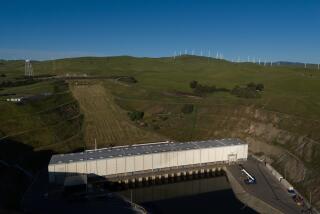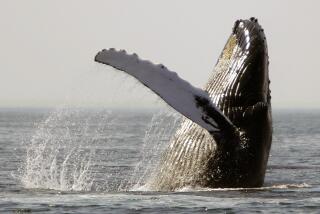Navy’s plan to deploy dolphins roils waters
SILVERDALE, WASH. — Some of the nation’s most sophisticated military submarines are based in the chilly waters of Puget Sound, an inlet of islands, peninsulas and harbors that is worryingly vulnerable to terrorist attack from a furtive diver or brazen suicide swimmer.
But the Navy’s plan to use a squadron of highly trained dolphins and sea lions to patrol and protect the submarine fleet is running into opposition from those who fear the glacier-fed waters of the sound are too frigid for warm-water dolphins.
Dolphins provide security for the Navy’s Kings Bay submarine base in southeast Georgia and have been deployed through the years in Vietnam, Bahrain and Iraq.
“Their strengths are that they are a mobile sensor: They have the best sensor we know about, and you can have them swim anywhere in the bay. They can outswim any man, they can localize the threat, and they can combine with the sea lions, which have good directional hearing,” said Steve Hugueley, who leads the marine mammal project at Kings Bay.
The Navy’s 78 dolphins, 27 sea lions and a beluga are trained to alert a patrol boat of human overseers when they detect a swimmer or diver in the security zone.
The animal is handed a floating marker to position on the surface above the suspect diver or swimmer.
Finally, the animal attaches a leg ring to the target that is connected by a line to the patrol boat, allowing security officers to reel the target in.
“It’s like people-fishing,” said Dorian Houser, civilian research scientist for the Navy’s marine mammal program in San Diego.
But the dolphins, which are based in San Diego, are accustomed to water temperatures averaging 10 degrees higher than those in Puget Sound. There are no native bottlenose dolphins in Puget Sound; the Pacific bottlenose dolphin normally is not found farther north than Santa Cruz.
And the dolphins the Navy plans to deploy in Puget Sound aren’t the Pacific dolphins native to California. They hail from the Atlantic, often captured in the warm waters of the Caribbean that may be 20 to 30 degrees warmer than those off Washington state, said Toni Frohoff, a dolphin biologist opposed to the dolphin deployment.
Average water temperatures at the Bangor submarine base, west of Seattle, range from 44.5 to 57.2 degrees. “It’s just a matter of being humane, or civilized, in acknowledging there’s a reason why bottlenose dolphins, especially the warm-water Atlantic variety, do not exist in the water here. It’s just too darned cold. And they don’t have the physiology to adapt,” Frohoff said.
Opposition to the Navy’s plans for the dolphins has coalesced into the group Knitting for Dolphins, which has launched a national campaign of volunteers knitting colorful dolphin-size sweaters.
Activists at Thursday night’s hearing near Seattle carried large placards saying “Will Knit for Dolphins.”
“It’s just a ridiculous idea. I mean, you know, they’re not cold-water dolphins. And I think a lot of people are opposed to using animals for war,” said Leigh Calvez of Bainbridge Island, Wash., who has been among the most vocal opponents.
Frohoff told Navy officials during one of two public hearings on the issue in the Seattle area this week that a marine mammal rescue group in Texas reported in 2007 that 25 dead dolphins had washed ashore along the Galveston County coastline.
Rescue leaders there said they believed the animals had become ill after exposure to colder-than-normal water the previous winter, according to news reports.
Navy officials say the dolphins have been trained successfully in very cold water, including wintertime stints in Alaska, Norway, Connecticut, Denmark and Germany.
“We had the animals out for many hours at a time, and they came back, and they were fine,” said Tom LaPuzza, public affairs officer for the Navy’s Space and Naval Warfare Systems Center in San Diego.
To allay concerns, the Navy is proposing to warm up the dolphins’ holding pens when the water temperature falls below 52.
But in comments at a Thursday night hearing, Humane Society International argued that studies had shown that moving the animals in and out of heated holding pens could be traumatic and compromise the animals’ immune systems.
The Humane Society and other opponents also have questioned whether dolphins can be relied on.
“I’ve been working with dolphins for over 20 years, both in captivity and in the wild. And most trainers who don’t have an affiliation will readily admit that dolphins do not have as accurate a response rate to directions and signals as human divers. So I think it isn’t just dangerous to dolphins, it’s dangerous to people,” Frohoff said.
Navy officials said dolphins provided valuable assistance in clearing mines in Iraq, allowing the port of Umm al Qasr to open. But the animals’ greatest asset under actual wartime conditions, during the Vietnam War, was as a deterrent, they said.
“In Cam Ranh Bay, they were getting weekly attacks with swimmers carrying explosives,” Hugueley said. Then dolphins were deployed, “and they didn’t have any attacks,” he said. “And when they took them away, they started getting attacked again.”
--
More to Read
Sign up for Essential California
The most important California stories and recommendations in your inbox every morning.
You may occasionally receive promotional content from the Los Angeles Times.










